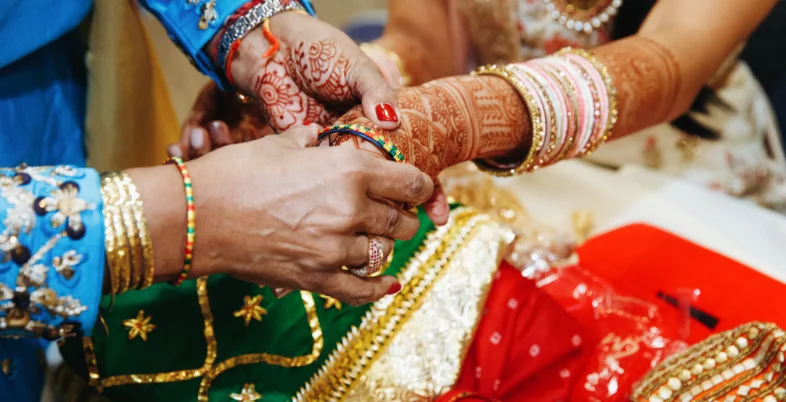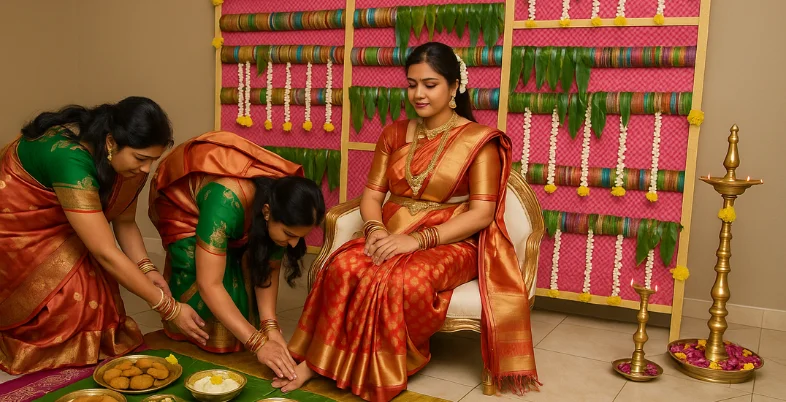In South Indian culture, pregnancy is not only seen as a biological journey but also a deeply spiritual one. One of the most cherished traditions that honors this phase is the Seemantham function, also known as “Srimantham” or “Valaikappu” in Tamil, and “Godh Bharai” in the North. This ceremony is a celebration of motherhood, praying for the health, prosperity, and safe delivery of both mother and child. Rich in symbolism, emotion, and ritual, Seemantham is a blend of tradition and joy that continues to hold immense cultural significance even today.
What Is Seemantham?
The term “Seemantham” describes a baby shower that is typically held in the seventh or ninth month of pregnancy in South India. Seemantham comes from Sanskrit and the word “seema” there means limit or border, indicating the close of the pregnancy. This ceremony is a way to bless the unborn child and protect the mother.
Cultural and Religious Significance
At its core, Seemantham is a Samskara — a rite of passage. It is mentioned in ancient Hindu scriptures as one of the essential 16 sanskaras (rituals) that sanctify different stages of life. The rite is thought to ward off evil spirits, improve the unborn child’s mental and spiritual health, and call forth the family deities’ blessings.
The spiritual essence of Seemantham lies in promoting positivity, calmness, and spiritual awareness for the expecting mother. It is believed that a serene and joyful atmosphere during this time has a direct impact on the emotional and mental development of the child in the womb.
When Is It Performed?
Seemantham is generally conducted during the 7th or 9th month of pregnancy — odd months being considered auspicious in Hindu tradition. The specific date and time are chosen based on astrological consultations, ensuring the ceremony takes place during an auspicious muhurtham (time window).
In some communities, Seemantham is celebrated only for the first pregnancy, while in others, a smaller version of the ceremony may be performed during subsequent pregnancies.
Rituals Performed During Seemantham
The Seemantham function is rich in Vedic traditions and cultural rituals. While the specific customs may vary slightly depending on the region and family traditions, some common rituals include:
1. Ganapati Pooja and Homam
In order to eliminate any obstructions, the event starts with a pooja, or prayer, to Lord Ganesha. Pooja decor ideas play a key role in setting a sacred and festive ambiance for the ceremony. A homam (fire ritual) is then conducted to purify the surroundings and invoke the blessings of various deities for a safe and smooth delivery.
2. Hair Parting Ritual (Seemantham)
The husband chants holy mantras while parting his wife’s hair three times during the ceremony’s main event. This act is symbolic of inviting positive energy and divine protection for both mother and child.
3. Valaikappu (Bangle Ceremony)

The mother-to-be is adorned with glass bangles of various colors, especially green and red. These bangles are said to produce soothing sounds that can be heard by the baby in the womb, fostering a sense of comfort and familiarity. Women from the family take turns to bless her and help her wear the bangles, often singing traditional songs.
4. Odiyaanam and Jewelry Blessings
In many Telugu and Tamil households, the mother-to-be is gifted traditional jewelry like the Odiyaanam (waist belt), mangalsutra, and gold or silver coins as a symbol of blessing and prosperity. These objects, which have been handed down through the years as family heirlooms, are regarded as fortunate.
5. Feeding Ritual and Special Foods
The ceremony ends with the pregnant woman being fed special dishes, including sweets and fruits, believed to bring good health to the mother and child. Certain traditional items like sesame rice, jaggery-based sweets, and protein-rich foods are commonly served.
Role of Family and Community
The ceremony is praised not just by the family but by the whole community as well. In order to bless and congratulate the newcomer, family members gather together. So many presents arrive at her home, including sarees, cosmetics, baby clothes, and ritual items used after childbirth.
Friends and family members sing old tunes and perform traditional dances to make the reunion more enjoyable. Having these celebrations provides the expectant mother with emotional support, making her feel happier and more confident.
Traditional Attire and Decoration

A significant highlight of the Seemantham function is the rich cultural attire and elaborate decorations. The expectant mother typically dons a vibrant silk saree that is embellished with gold jewelry, flowers, and other decorations. Fresh jasmine, lotus blossoms, and traditional poola jadas (flower braids) adorn her hair, adding to her exquisite and dazzling appearance.
Usually, brass lights, flower rangolis, banana trees, and mango leaves are used to decorate the space. These days, a lot of families choose themed decoration that combines traditional and contemporary design elements to create an Instagram-worthy arrangement while maintaining cultural authenticity.
Modern-Day Seemantham Celebrations
While the essence of Seemantham remains intact, modern families often incorporate contemporary elements to suit current lifestyles. Many couples organize professional photo shoots during the ceremony. Event planners, decorators, and caterers are hired to manage the function smoothly. Some even merge the Seemantham with a Western-style baby shower, combining rituals with games and gift exchanges.
The Importance of Poola Jada in Seemantham
One of the standout elements of a traditional Seemantham is the Poola Jada (floral braid) worn by the expecting mother. This ornate braid is not just an accessory but a symbol of fertility, prosperity, and divine feminine energy. Intricately woven with fresh flowers like jasmine, roses, and chrysanthemums, the Poola Jada enhances the elegance of the mother-to-be and brings spiritual significance to the occasion.
Visit our Instagram page for more details
Conclusion
In conclusion, the Seemantham function is a beautiful confluence of love, blessings, tradition, and spirituality. Through protective and meaningful rituals, it acknowledges and celebrates the amazing experience of motherhood. A new beginning, an expanding family, and the cultural thread that unites generations are all celebrated throughout this event, which is more than just a religious ceremony.
FAQ
Can Seemantham be combined with other functions like a baby shower or naming ceremony?
Yes, especially in modern times, families sometimes combine Seemantham with a baby shower or even a pre-naming ceremony if the timing aligns. However, these events have different religious and cultural significance, so combining them should be done thoughtfully with guidance from elders or a priest.
Are there any food restrictions for the expecting mother during or after the Seemantham ceremony?
While there are no fixed dietary rules during the Seemantham, traditional foods rich in iron, protein, and ghee are usually prepared. Spicy or heavy dishes may be avoided depending on the mother’s health. Post-ceremony, many families observe a sattvic (pure and vegetarian) diet for a few days as a form of spiritual discipline.
What kind of gifts are appropriate for the Seemantham function?
Gifts for Seemantham typically include sarees, jewelry, bangles, baby essentials, and spiritual items like silver utensils or idols. Modern guests also give maternity wear, skincare hampers, or gift vouchers. Gifts that are practical and culturally thoughtful are always appreciated.

